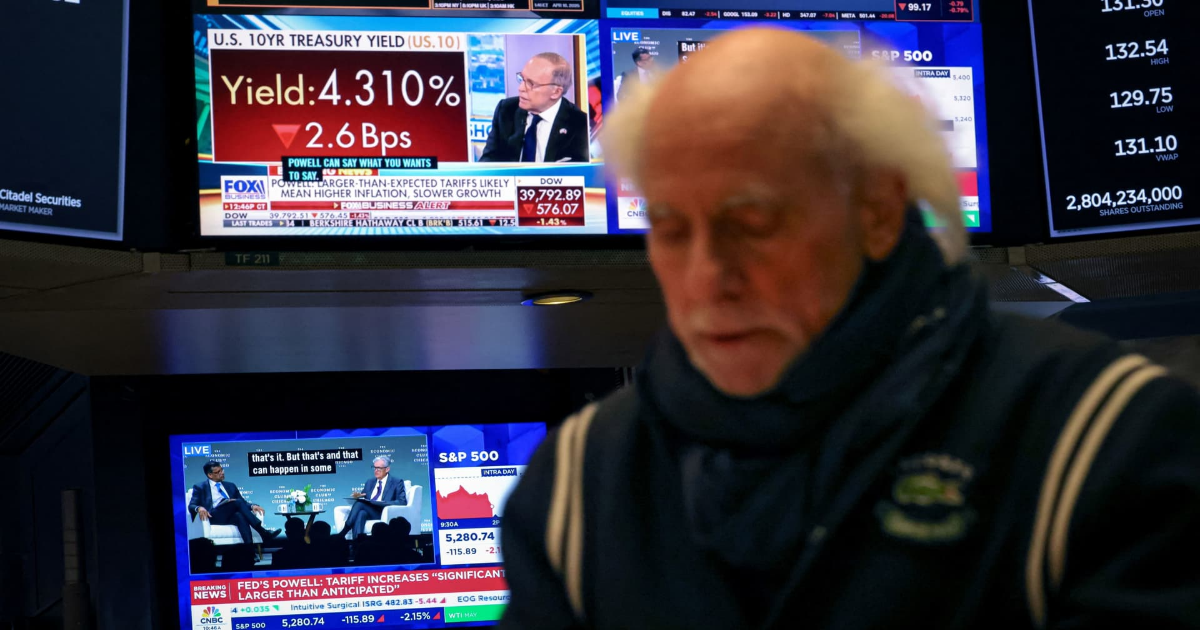A trader works, as a screen broadcasts a live interview with U.S. Federal Reserve Chair Jerome Powell, on the floor at the New York Stock Exchange in New York City, U.S., April 16, 2025.
Brendan McDermid | Reuters
Stock futures rose modestly Wednesday night after a steep sell-off in the prior session.
Futures tied to the Dow Jones Industrial Average added 62 points, or 0.15%. S&P 500 futures advanced 0.2%, while Nasdaq 100 futures climbed 0.3%.
Major stock indexes sank on Wednesday, led by a significant decline in technology stocks and mounting tariff worries.
The Dow Jones Industrial Average lost 1.7%, or nearly 700 points. The S&P 500 dropped about 2.2%, while the tech-heavy Nasdaq Composite declined nearly 3.1%. The Nasdaq ended the session roughly 19% off its closing high, bringing it closer to bear market territory.
Chipmaking giant Nvidia lost 6.9% in the previous session after disclosing a quarterly charge of about $5.5 billion tied to exporting its H20 graphics processing units, or GPUs, to China and other destinations due to U.S. export controls. Other semiconductor stocks, including AMD and ASML, also sold off as investors’ realized that greater uncertainty from new U.S. President Donald Trump’s tariff plans could affect demand for chips.
Stocks hit session lows during Wednesday afternoon after Federal Reserve Chair Jerome Powell said before the Economic Club of Chicago that Trump’s levies could drive up inflation in the near term and are “likely to move us further away from our goals.” Powell said the central bank may find itself in a “challenging scenario” in which its dual-mandate goals — which are to achieve maximum employment and stable prices — are in tension.
“Despite the fact that Powell said that the dual mandate wasn’t currently in opposition, he clearly touched a nerve with investors, who are now worried that a recession and stagflation is more likely,” said Chris Zaccarelli, chief investment officer for Northlight Asset Management.
Trading activity has been volatile ever since the Trump announced its sweeping “reciprocal” tariffs on April 2, many of which were put on hold for 90 days last week while tariffs on China rapidly escalated. Trump’s surprise tariff exemption against smartphone and PC imports announced over the weekend provided some brief respite for markets, leading stocks higher on Monday. The major averages have since posted back-to-back losing days.
Investors remain concerned about the economic impact of tariffs, particularly as earnings season ramps up.
“I think the economy is on very weak knees right now,” Bleakley Financial Group chief investment officer Peter Boockvar said Wednesday evening on CNBC’s “Fast Money.”
The S&P 500 and Nasdaq have dropped about 6% and 5.7%, respectively, this month. The 30-stock Dow has lost about 5.6%.
Stocks head for weekly loss
Major U.S. indexes are heading for a weekly decline. The S&P 500 has tumbled 1.63% this week, while the Nasdaq Composite is down 2.5%. The 30-stock Dow has lost 1.35%.
— Pia Singh
U.S. importers are receiving an increase in canceled sailings by freight ships coming out of China, resulting from a pullback in orders driven by President Donald Trump’s tariff policies.
Freight company HLS Group recorded a total of 80 canceled sailings out of China, and wrote in a note to clients that carriers have started to suspend or adjust transpacific services amid the U.S.-China trade war. The impact of the diminished freight container traffic to North America will impact links in the economy and supply chain, including the ports and logistics companies moving the freight.
China now faces up to a 245% tariff on imports to the U.S., the White House said on Tuesday, although that excludes several electronic devices after Trump’s latest tariff exemption. Beijing said last week raised its levies on U.S. goods to 125%.
Read more here for what freight experts told CNBC.
— Lori Ann LaRocco, Pia Singh
